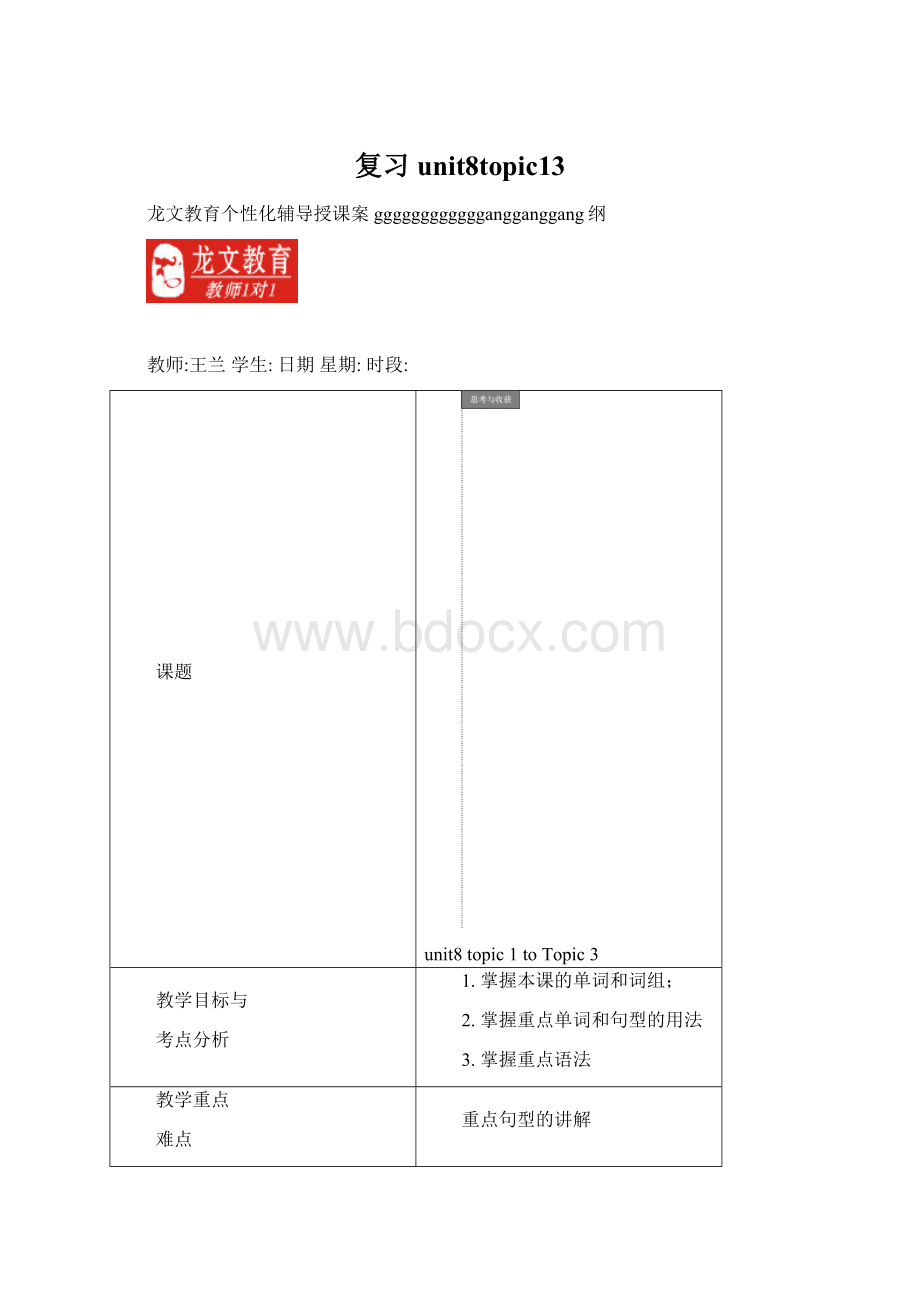复习unit8topic13.docx
《复习unit8topic13.docx》由会员分享,可在线阅读,更多相关《复习unit8topic13.docx(16页珍藏版)》请在冰豆网上搜索。

复习unit8topic13
龙文教育个性化辅导授课案ggggggggggggangganggang纲
教师:
王兰学生:
日期星期:
时段:
课题
unit8topic1toTopic3
教学目标与
考点分析
1.掌握本课的单词和词组;
2.掌握重点单词和句型的用法
3.掌握重点语法
教学重点
难点
重点句型的讲解
教学方法
启发法,讲述法,练习法
一.单词讲解及听写
(二)短语:
1.onthefirstfloor在一楼
2.get…from…从……中得到……
3.shoppingcenter购物中心
4.catchone’seye吸引某人的注意
5.gowith…与……相配
6.onspecialdays在特殊的日子
7.infact事实上,实际上
8.thanksgivingDay感恩节
9.dependon依靠,依赖,相信
10.It’ssaidthat据说
11.SantaClaus圣诞老人
12.thesame…as…与……一样
13.protect…from…保护……使不受……
14.aswellas也,还
15.bemadeof/from由……制成
一.重点句型:
1.what’sitmadeof?
它是由什么做成的?
bemadeof意为“由……制成”(看出原料),类似结构的短语还有
bemadefrom“由……制成”(看不出原料)
bemadein“某物生产于某地”
bemadeupof“由……组成”
bemadeinto“把……作成某产品”如:
Thetableismadeofwood.这张桌子是木头制成的。
Paperismadefromwood.纸是木材做成的。
TheTVsetismadeinJapan.这台电视机是日本产的。
Themedicalteamismadeupoftendoctors.这支医疗队由十位大夫组成。
Bamboocanbemadeintowalkingsticksandfishingrods.
用竹子可以制成很好的拐杖和钓鱼竿。
2.Theweatherisgettingwarmerandwarmer.天气变得越来越暖和了。
“比较级+and+比较级”表示“越来越……”如:
Thelittletreeisgettingtallerandtaller.那棵小树越来越高了。
对于多音节的形容词或副词则这样表达moreandmore+adj/adv.如:
Thegirlbecomesmoreandmorebeautiful.
那个女孩变得越来越漂亮了
3.Wecangetcottonfromplantsandgetwool,silkandleatherfromanimals.
我们可以从植物中获得棉花,从动物中获得羊毛、丝绸和皮革。
getsth.from/sth./sb.从某事或某人处获得某物。
4.A…caughthereye.一个……引起了她的注意。
如:
catchone’seye意为“吸引某人的注意”如:
Canyoucatchtheteacher’seye?
你能引起老师的注意吗?
5.Whatthepeoplethereweardependsontheirlikesanddislikes.
人们的衣着取决于他们的喜好。
dependon意为“依靠、依赖”如:
Wedependonourhardwork.我们依靠我们的努力工作。
6.Somepeopleprefertodressformally…一些人宁可打扮得正式些
prefer宁肯,更喜欢……,preferAtoB=likeAbetterthanB
Ilikeprefersinging=Ilikesingingbetter.我更喜欢唱歌。
Ipreferswimmingtoskating.比起滑冰我更喜欢游泳。
7.WhilemanySouthAmericanpeoplehavethesamewayofdressingasAustralia?
然而许多南美的人们和澳大利亚有相同的衣着方式。
While用于对比两件事物,意为“而……,然而……”
Michaelisinterestedinmusic,whilehisbrotherprefersP.E.
迈克对音乐感兴趣,而他的兄弟却更喜欢体育。
thesame…as和……一样/相同,反义词:
bedifferentfrom…与……不一样,如:
Myideaisthesameasyours,butit’sdifferentfromhis我的主意和你的一样,但和他的不一样。
8.Peoplefirststartedwearingclothestoprotectthemselvesfromthesun,wind,rainandcold.人们最早穿衣服是为了保护他们不受日晒、风吹、雨打以及寒冷。
protect…fromsth/doingsth阻止……做……
Thetreescanprotectthesandfrommoving.树可以防止沙子向前移。
Trytoprotectyourskinfromthesun.尽量保护你的皮肤不受太阳暴晒。
二.语法学习:
感叹句
(1)感叹句用于表示说话时的一种较为强烈的感情。
如:
喜悦、赞叹、惊异、愤怒、厌恶等。
感叹句的构成为“感叹部分+陈述部分+(主语+谓语)”,感叹部分由感叹词引导,陈述部分为整个感叹句的主语和谓语,句尾要用叹号“!
”,读时要用降调。
如:
Whatanicedayitis!
多好的天气!
Whatagoodboyheis!
多好的男孩!
Howsillyyouare!
你真傻!
Howbeautifulitis!
它多美啊!
(2)感叹句的四种形式:
What+a(an)+名词单数+主语+谓语
What+形容词+可数名词复数/不可数名词+主语+谓语
How+形容词+主语+be
How+副词+主语+动词
(3)口语中,what或how引导的感叹句可省略主语+谓语。
如:
Whataninterestingbook!
/Howinteresting!
(4)what与how引导的感叹句之间的转换。
Whatabeautifulgirlsheis!
=Howbeautifulthegirlis!
Howdeliciousthefoodis!
=Whatdeliciousfooditis!
1.YouknowwewillhaveaclassfashionshownextMonday.
Show
(1)名词,展览,演出。
短语:
beonshow在展览
(2)动词,给…看.短语:
showsb.around带某人参观
SectionB
1.Whatdoyouthinkofthem?
Whatdoyouthinkofsb./sth.?
表示对某人或物的看法。
类似句型有:
Howdoyoulike…?
如:
WhatdoyouthinkofEnglish?
=HowdoyoulikeEnglish?
-----It’sinteresting.
2.SizeS(S=small)小号;SizeM(Medium)中号;SizeL(L=large)大号;SizeXL特大号
3.Thecoolestpantsaresoexpensivethathecan’taffordthem.
afford担负得起(常与“can;could;beableto”连用)如:
Ican’taffordacar.
SectionC
1.HowdoNorthAmericansdress?
dress在此为动词,意为“给…穿衣”句型有:
(1)dresssb./oneself给某人穿衣:
Shedressesthebabyeveryday.
(2)dressin+颜色/衣服:
穿着:
Sheisdressedinwhitetoday.(常用;bedressedin结构)
(3)dressup打扮,化装:
Let’sdressupandgoouttotheball.
注意:
dress后可直接接人,但不能直接接衣服,但dressin可接衣服。
2.bethesameas与…一样,(反义:
bedifferentfrom与…不同)如:
Myideaisthesameasyours,butitisdifferentfromhis.
3.accordingto+名词短语。
表“根据…”:
Accordingtowhatyousaid,itisagreatmovie.
4.nearly几乎,常可与almost换用,但在具体的数字前常用nearly.如:
Itisnearly
twentymetershigh.
(2)almost可用于no,nothing等前,但nearly不可。
如:
Almostnoone(=Hardlyanyone)believesher.
5.catchone’seye引起某人的注意WhenIwalkingonthestreet,abeautifulgirlcaughtmyeye.
SectionD
1.
(1)morethan多于,不仅仅Sheismorethanateacher,sheisalsoourfriend.
(2)nomorethan不超过Theboyisnomorethanfive.
2.Asthesayinggoes,“Youarewhatyouwear.”
Asthesayinggoes常言道,正如谚语所说。
3.so…that和such…that的用法:
如此…以致….
(1)so+形容词/副词+that从句:
HeransofastthatIcouldn’tcatchupwithhim.
(2)such+(a/an)+形容词+名词+that从句:
“(a/an)+形容词+名词”也叫名词短语。
ItwassuchbadweatherthatIhavetostayathome.(weather是不可数名词,前不要a)
(3)当名词前有many,much,few,little等表数量多少的词修饰时,应用so,而不用such.
ThereweresomanynicebooksinthebookstorethatIcouldn’tdecidewhichtobuy.
(4)当单数名词前有形容词时,既可用so,也可用such,但a/an的位置却有所不同。
Thisissuchanimportantmeetingthatyoushouldattend.
=Thisissoimportantameetingthatyoushouldattend.
4.题:
Manygirlswouldliketoskirtsinsummer.
A.putonB.dressC.haveD.wear
5.题:
Couldyoutellme.
A.wheretobuyB.wheretobuyitC.whereIwillbuy.
Unit8Topic2
SectionA
1.Ourschoolplanstomakeuniformsforyou.
(1)uniform制服aschooluniform.一套校服
(2)clothes衣服(3)clothing服装(除了含clothes的意思外,还包括帽子,鞋袜等)
2.Uniformswilllookuglyonus.
lookuglyonus穿在身上很难看
3.Ithinkourschoolshouldallowustodesignourownuniforms.
(1)allowsb.todosth.允许某人做某事Pleaseallowmetocarryyourbag.
(2)可说allowdoingsth.,不可说allowtodosth.但被动可:
sb.beallowedtodosth
如:
Theyallowedsmokinginthisroomonly.
(3)allowsb.in/out允许某人进/出
①Shewon'tallowthechildreninuntilthey'vewipedtheirshoes.
②Sheisnotallowedoutafterdark.
4.Itistruethatsuitableuniformscanshowgooddiscipline.
show在此指“表明,展示”Heshowedgreatinterestinpainting.
5.Sometimeswewearplainclothestocarryoutspecialtasks.
(1)plainclothes便装
(2)carryout执行Wewillcarryoutourplannextweek.
SectionB
1.Youshouldtakeoffyourshoeswhenyouentersomeone’shomeinJapan.
takeoff
(1)脱下,反义puton.
(2)飞机起飞Theplanewilltakeoffsoon.
2.句型:
(1)Itis+形容词+(forsb)todosth.
Itisnecessaryforustodosomeexerciseeveryday.
(2)Itis+形容词+that从句
Itisnecessarythatweshoulddosomeexerciseeveryday.
SectionC
Whenofficialsdressintheirbestuniforms,theylookimportant.
dressin=wear穿着(dress的详细用法见上个话题)
SectionD
1.Tomgiveshissistersomeadviceintheletter.
(1)表“建议”:
advice不可数名词。
suggestion可数名词
(2)givesb.someadvice=givesomeadvicetosb.
(3)advise动词,建议:
advisesb.todosth.建议某人去做某事
2.Iwanttotellyousomethingabouttheartofdressing.
(1)tellsb.about告诉某人关于…Pleasetellmeaboutyourself.
(2)tellsb.sth.告诉某人某事:
Pleasetellmethetruth.
Unit8Topic3
SectionA
1.Didyouwatchthefashionshowlastnight?
(1)watch观看(活动的画面)watchTV
(2)see看到(强调结果)Isawyouinthestreetyesterday.
(3)look看(后不能直接接宾语,须与at连用,lookat表“往…看”)
Pleaselookattheblackboard.
(4)notice注意,注意到Didyounoticeanythingunusual?
2.特殊疑问句有两种语序:
(1)当疑问词作主语,即对主语或主语的定语提问,其语序是陈述句的语序:
疑问词(+主语)+谓语动词+其他成分?
如:
①whoissingingintheroom?
----Janeissingingintheroom.(对主语Jane提问)
②whosebikeisbroken?
---Jane’sbikeisbroken?
(对主语bike的定语Jane’s提问)
(2)如疑问词作其他成分,即对其他成分提问,其语序是:
疑问词+be/情态动词/助动词+主语+其他成分?
(即主语放谓语动词后)如:
①whatclassareyouin﹖---IaminClassThree(对宾语提问)
②Whatcanyoudo?
③Whatdoesshelooklike﹖
3.pantswithtwopockets带有两个口袋的裤子
With表“有,带着”,with构成的介词短语常做后置定语,反义词是without,如:
①aboywithbigeyes②aroomwithtworeddoors③aroomwithoutwindows
SectionB
1.Asfortheothers,I’mnotsure.
Asfor表“至于…”
2.多个形容词的顺序:
在英语中,当名词有多个形容词修饰时,就有它们的先后顺序。
下面的口诀可帮你记住这一先后顺序:
“限定描绘大长高,形状年龄和新老;颜色国籍跟材料,作用类别往后靠。
”
其中,“限定词”包括:
冠词、物主代词、指示代词、或数词,它位于各类形容词前。
“描
绘”性形容词如:
beautiful、bad、cold、great等。
“大长高”表示大小、长短、高低等一些词。
表示“形状”的词如:
round,square等。
“国籍”指一个国家或地区的词。
“材料”的词如:
wooden,woolen,stone,silk等。
“作用类别”的词如:
medical,college,writingdesk,policecar等。
题:
Onedaytheycrossedthe____bridgebehindthepalace.
A.oldChinesestoneB.Chineseoldstone
C.oldstoneChineseD.Chinesestoneold
答案A.几个形容词修饰一个名词,他们的排列顺序是:
年龄,形状,大小+颜色+来
源+质地+用途+国家+名词。
SectionC
1.TheTangcostumegotitsnamebecauseChinabecameknowtoothercountriesduringtheHanandTangdynasty.
(1)getitsname得名
(2)①become/beknownto为…所熟知,例如上。
②beknownfor因…而出名
③beknownas以…身份而出名(know的用法同famous)
2.TodaypeoplecandesigntheTangcostumeaseitherformalorcasualclothes.
design…as…表“把…设计成…”通常用被动形式:
bedesignedas
SectionD
1.ThemostwidelyknownitemofAmericanclothingisbluejeans.
Widelyknown(=well-known)表“广为人知的”
2.Atonetime,Japanesepeopleworekimonosforcasualandformaloccasions.
atonetime(过去)有个时期;曾经:
Wewereclassmatesatonetime.
3.Today,hardlyanyonewearskimonosexceptonspecialoccasionslikemarriages.
(1)hardly表“几乎不”,是否定词:
Hehardlyknewwhattosay,didshe?
(2)except表“除了”;besides表“除了…还有”,相当于aswellas
4.IthoughtJenny’sdresswasoutofstyle.
(1)outofstyle表“过时的”;
(2)instyle/fashion表“时尚的,流行的”
()1.Thefashionshowis____wonderful____wealllikeit.
A.too;toB.so;thatC.such;thatD.very;that
()2.—Wouldyouliketohavealookatsomepants?
Theymayfityouwell.
—Well,I’dliketotrythoseblue____.
A.pairsB.oneC.pantD.pair
()3.Thegirlwantedtomakealotofmoney____shecouldbuythesilkcheongsam.
A.andB.butC.sothatD.because
()4.Themanis____thanhisfather.
A.handsomeB.muchhandsome
C.morehandsomeD.morehandsomer
()5.Hisparentsdon’tallowhim____.
A.s